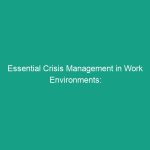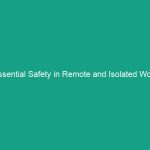Good Morning Team!
Today, we’re going to discuss an extremely important topic: Must-Know Winter Weather Guidelines: Stay Safe and Avoid Risks. As winter approaches, it’s vital that we understand how to protect ourselves from the Hazards that come with it. With the right knowledge and Precautions, we can ensure a safe working Environment during these chilly months.
Understanding Winter Weather Guidelines
Winter weather guidelines are a set of recommendations and Best Practices designed to help employees navigate the challenges posed by cold temperatures, snow, ice, and severe weather conditions. These guidelines are crucial for maintaining Safety and productivity in our daily operations. Ignoring these protocols can lead to serious injuries, accidents, and even fatalities.
One common misconception is that winter weather only affects outdoor work. In reality, it can impact indoor environments too, such as causing slips and falls on wet floors or dealing with heating issues in poorly insulated buildings. Understanding these guidelines helps to mitigate risks across all areas of our workplace.
Key Hazards, Risks, and Safety Considerations
As we dive deeper into winter weather guidelines, it’s essential to recognize the specific hazards we face:
- Slips and Falls: Icy surfaces can create dangerous conditions. Falls are common and can result in serious injuries.
- Hypothermia and Frostbite: Exposure to cold temperatures can lead to life-threatening conditions if not addressed appropriately.
- Driving Hazards: Snow and ice can make commuting to and from work treacherous.
- Heavy Snow Accumulation: Roofs can collapse under the weight of accumulated snow, posing a risk to workers indoors and outdoors.
- Equipment Malfunctions: Cold weather can affect the performance of machinery and tools, potentially leading to accidents.
Best Practices, Procedures, & Actionable Advice
Here are some practical steps you can take to stay safe during winter:
1. Dress Appropriately
Wear layers of clothing to maintain body heat without overheating. Ensure that your outer layer is waterproof and windproof. Don’t forget insulated gloves, hats, and appropriate footwear to prevent frostbite.
2. Maintain Awareness of Conditions
Stay informed about weather forecasts and conditions. If severe weather is predicted, plan accordingly and communicate with your supervisor about any potential work disruptions.
3. Use Caution When Walking
When walking outdoors or in potentially icy areas, take smaller steps and use handrails where available. Look for slippery spots and avoid rushing.
4. Ensure Proper Vehicle Safety
Before driving in winter conditions, ensure your vehicle is winter-ready. This includes checking tire tread, battery life, and having an emergency kit on hand.
5. Handle Snow and Ice Carefully
When shoveling snow or using ice melt, use proper techniques to avoid straining your back. Take breaks and stay hydrated.
6. Report Hazards
If you notice any hazards, such as ice or snow accumulation in work areas, report them immediately to your supervisor so they can be addressed promptly.
7. Stay Alert for Equipment Issues
Cold weather can affect equipment performance. Regularly inspect tools and machines for any malfunctions, and report issues immediately.
Real-World Examples
To emphasize the importance of these guidelines, let’s look at a few real-world incidents:
- In 2020, a construction worker slipped on an icy surface and suffered a serious injury that required time off work. Proper signage and Precautions could have prevented this incident.
- A warehouse employee faced frostbite due to inadequate clothing during a sudden drop in temperature while working outdoors. Ensuring the right attire could have mitigated this risk.
Regulations, Standards, and Compliance
Following winter weather guidelines is not just a best practice; it is also a matter of compliance with OSHA and other safety Standards. osha mandates that employers provide a safe working environment, which includes taking necessary Precautions during winter months.
Non-compliance can lead to severe penalties and, more importantly, jeopardize your safety and the safety of your colleagues. Always prioritize adherence to safety protocols to ensure everyone goes home safe at the end of the day.
Employee Engagement & Discussion
Now that we’ve covered these important guidelines, let’s open the floor for discussion. What challenges have you faced in winter weather conditions at work? Sharing your experiences can help us all stay informed and prepared.
Conclusion & Key Takeaways
In summary, understanding and following winter weather guidelines is critical for ensuring safety in the workplace. Remember to dress appropriately, maintain awareness of conditions, and report hazards promptly. By taking these proactive steps, we can protect ourselves and our coworkers from the risks associated with winter weather.
Thank you all for your attention and your commitment to safety. Let’s work together this winter to ensure a safe and productive season!


